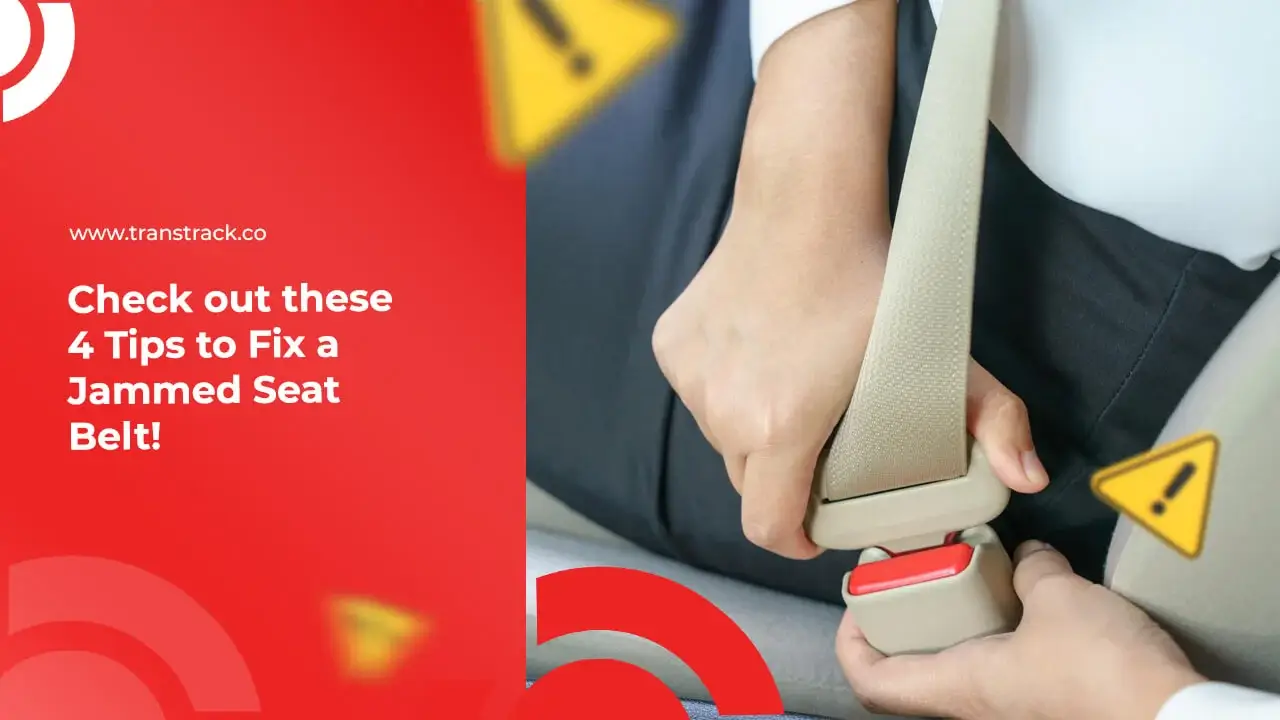Check out these 4 Tips to Fix a Jammed Seat Belt!

Seat belts are one of the most important safety features in a car that has saved many lives in traffic accidents. However, sometimes even such a small component can have problems. One common problem that drivers often face is when the car seat belt gets stuck.
When a seat belt gets stuck, it not only interferes with the comfort of the driver and passengers, but also reduces its effectiveness in providing protection during an accident. The causes of seat belt jamming can vary, ranging from sudden braking to wear and tear from constant use.
In this TransTRACK article, we will discuss some of the common causes why car seat belts can get stuck, as well as provide tips on how to solve the problem and keep the seat belt in good working order. In addition, we will also introduce modern solutions such as TransTRACK’s Seat Belt Sensor that can help detect seat belt issues more quickly and efficiently.
Let’s explore more about the problem of seat belt jamming and the steps we can take to keep ourselves safe on the road.
Causes of Car Jammed Seat Belt
The common causes of car seat belt jamming can be quite a serious problem for safety. Here are some common causes:
Sudden Braking
When you brake suddenly, the seat belt system will respond by locking the seat belt to prevent you from being thrown forward in an accident or strong braking situation. However, in some cases, if the seat belt’s emergency locking system fails or is too sensitive, the seat belt may become stuck and cannot be released after the incident.
There is Dirt in the Internal Retractor Mechanism
Dirt or dust entering the internal mechanism of the retractor can interfere with seat belt movement. The retractor is an important part of the seat belt mechanism that is responsible for ejecting and retracting the belt. If dirt gets in, the retractor may not function properly, causing the seat belt to jam.
Leaning Forward Too Fast
When you pull the seat belt quickly or too hard, the seat belt’s internal mechanism may not be able to adjust to the speed of the pull. This can cause the seat belt to jam inside the retractor or even damage its internal components.
Long Aged and Worn
Seat belts that have been used for a long time tend to experience wear and tear. Wear and tear of materials, especially on frequently used parts such as the retractor mechanism and buckle fastener, can cause interference with the function of the seat belt. Wear and tear of the seat belt can also make it more prone to jamming or even breaking during use.
In all of the above cases, it is important to perform regular maintenance and checks on your seat belts to ensure that they are functioning properly and providing optimal protection. If you encounter any problems with your seat belt, it should be repaired immediately by a trained mechanic to ensure your safety while driving.
How to Fix a Jammed Car Seat Belt
Here are some ways you can try to overcome a stuck car seat belt:
Using Lubricants
If the problem is due to dirt or stiffness in the retractor mechanism, you can try using a lubricant specifically designed for such devices. Be sure to read the instructions for using the lubricant carefully and only use the appropriate amount.
Using Manual Pressure
Sometimes, applying manual pressure to the seat belt while pulling it slowly can help release a jammed belt from the retractor. However, be sure not to apply too much pressure so as not to damage the internal components of the seat belt.
Consult a Technician
If your car seat belt problem cannot be resolved by simple means, it is highly recommended to consult an experienced technician or mechanic. They have the necessary knowledge and equipment to handle seat belt issues safely and effectively.
Check the Physical Condition of the Seat Belt
It is always important to regularly check the physical condition of your seat belt. Look out for any signs of wear, damage or dirt that might interfere with the seat belt’s function. If you encounter any problems, take immediate repair or replacement action as needed.
Remember that your safety comes first, so be sure to address seat belt issues quickly and appropriately. If you’re unsure of how to fix a seat belt issue, it’s best to seek help from a professional.
Tips to Keep the Car Seat Belt from Jamming
Keeping the car seat belt from getting stuck requires regular attention and maintenance. Here are some tips to help keep the seat belt in good working order:
Pay Attention to Seat Belt Tension
Make sure your seat belt is properly tensioned every time you use your car. The right tension will help keep the seat belt in a secure position and be effective in providing protection during an accident. Also make sure not to over-tension the seat belt, as this can reduce its effectiveness.
Regular Maintenance
Perform regular maintenance on your car seat belt. This includes cleaning any dirt or dust that may be stuck to the seat belt and retractor mechanism. You can also use a soft brush or vacuum cleaner to clean hard-to-reach crevices. Also, make sure to periodically check the physical condition of the seat belt to detect any signs of wear or damage.
Avoid Sudden Braking
Sudden braking can cause the emergency locking system in the seat belt to activate, which can jam the seat belt. Try to avoid braking too hard or suddenly as much as possible. Always drive carefully and obey the speed limit to reduce the risk of accidents or sudden braking situations.
Pay Attention to Temperature and Humidity
If your car is exposed to extreme temperatures or high humidity, this can also affect the performance of the seat belt. Avoid leaving your car parked in direct sunlight for long periods of time, as excessive heat can damage the seat belt material. If you live in an area with high humidity, be sure to keep the car interior dry to prevent corrosion or damage to the seat belt components.
By paying attention to tension, performing regular maintenance, avoiding sudden braking, and paying attention to the surrounding environmental conditions, you can help keep your car seat belt from getting stuck and keep it functioning properly to protect your safety while driving.
With so many factors that can affect the performance of a car seat belt, keeping the system in good working order is an important step in keeping you safe on the road. From sudden braking to high humidity, there are many things to consider.
However, with technology continuing to advance, there are now solutions that can help detect problems with seat belts more quickly and efficiently. One interesting solution is using TransTRACK’s Seat Belt Sensor.
With this Seat Belt Sensor, you can monitor the condition of your car’s seat belt in real-time and receive notifications in the event of a problem, such as a jammed or broken seat belt. This allows you to take appropriate precautions before the problem becomes more serious.
With that said, let us together take proactive steps to keep us safe on the road by using advanced technology such as the Seat Belt Sensor from TransTRACK. Let us commit to ensuring that our every journey is safe and comfortable for all passengers.
Topic





